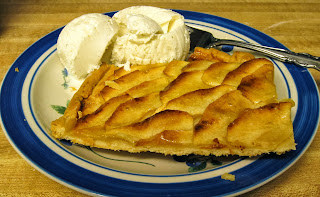October 20, 2013
Menu
Eggs Benedict
Mimosa
Recipe
You don't know if you'll like something until you try it, at least that's what my parents told me. I've always had an aversion to runny egg yolks. I order fried eggs "over hard" with the yolks broken and cooked. Diane prefers her fried eggs sunny side up and enjoys runny yolks. She regularly meets a friend for brunch and orders a version of Eggs Benedict which features poached eggs and their runny yolks. (I think she gets a California Benedict. When you add avocado to a dish you get to add "California" to the name.") While there are many variations to the dish, in its simplest form it is a toasted English muffin with Canadian bacon, a poached egg, and Hollandaise sauce.
I had never poached an egg or made Hollandaise sauce. I had recently watched a video demonstrating an egg poaching technique and this inspired me to prepare a favorite dish of Diane's despite my misgivings about runny yolks. When reading about the sauce there are warnings galore about it "breaking". Hollandaise sauce is an emulsification of fat and water (the ingredients are egg yolk, butter, lemon juice, and water) and if not handled correctly the fat and water can separate. The sequence and timing of the steps–making the toast, warming the Canadian bacon, making the sauce, cooking the eggs–so everything came together at the right temperature was also a concern.
In the end, everything came out fine. It's a pretty simple and pretty complete meal (well, unless you insist on vegetables) and it took only about 35 minutes to prepare, much of that prep work. The sauce did not break, which was a relief. After cooking it in a double boiler I kept it warm by holding it over the hot water which had been removed from the heat. The sauce was nice and smooth though a little bland. I had omitted the optional cayenne pepper and next time I will include it and add more salt, too. The eggs were slightly overcooked: I checked them after four minutes and the whites still looked a little loose, so I put the cover back on the skillet for another minute. They were still runny but a little thicker than desired.
Overall I was pretty happy with this dinner, especially for a first try. I didn't find the runny yolks as revolting as they were in my memory. I'll have to try a restaurant version of eggs Benedict to see how it compares to what I made, and then prepare it again for dinner.
Not on Sunday
Since there are no leftovers when you fix breakfast for dinner and we had little food in the refrigerator after being out of town the previous week, I cooked up a pot of chili on Monday using the recipe for Quick Beef and Bean Chili that I described in February. I bought fresh chili powder and cumin which improved an already good dish. To go with it I baked sourdough whole wheat bread, replacing the yeast in the Test Kitchen's Almost No-Knead Whole Wheat Bread recipe with ¼ cup of sourdough starter. The starter, which I now feed every other week, keeps getting better and better and this bread developed a real nice tang. Feeding it and letting it sit at room temperature before using it probably helps the flavor and activity.
















